 Notes: The AA Illustrated road book of England & Wales (1961) dismissed Holmfirth with not so much as a description, merely noting its population of 18,790, early closing day on Tuesday and market day on Thursday, then referring to Saddleworth Moor and Holme Moss BBC television transmitter. Thanks to the BBC the town is now a tourist destination as the setting for the much-loved comedy Last of the Summer Wine; earlier generations chuckled (or winced!) at the saucy seaside postcards produced by Bamforth’s of Holmfirth. The town owes its growth to the woollen industry, originally found in cottages on the surrounding hills where spinning and weaving was carried out and fine worsteds were manufactured. In the late eighteenth and nineteenth centuries production migrated downhill to water mills within Holmfirth’s steep valley, powered by swift streams and, later, reservoirs. Terraces and cottages of sandstone clamber up the steep valley sides of this quaint Pennine town, which was reached in 1850 by a branch railway. The economy of the town was boosted by its new railway and by the use of steam power in the mills which used coal brought in by rail. Notes: The AA Illustrated road book of England & Wales (1961) dismissed Holmfirth with not so much as a description, merely noting its population of 18,790, early closing day on Tuesday and market day on Thursday, then referring to Saddleworth Moor and Holme Moss BBC television transmitter. Thanks to the BBC the town is now a tourist destination as the setting for the much-loved comedy Last of the Summer Wine; earlier generations chuckled (or winced!) at the saucy seaside postcards produced by Bamforth’s of Holmfirth. The town owes its growth to the woollen industry, originally found in cottages on the surrounding hills where spinning and weaving was carried out and fine worsteds were manufactured. In the late eighteenth and nineteenth centuries production migrated downhill to water mills within Holmfirth’s steep valley, powered by swift streams and, later, reservoirs. Terraces and cottages of sandstone clamber up the steep valley sides of this quaint Pennine town, which was reached in 1850 by a branch railway. The economy of the town was boosted by its new railway and by the use of steam power in the mills which used coal brought in by rail.
Although the branch was double-track Holmfirth station possessed one side platform, east of the rails, with a bay set behind it. Had proposed extensions of the branch gone ahead a second side platform would have been added. The station building was a handsome Tudor sandstone villa with steeply pitched roofs and three sets of tall, coupled chimneystacks. At either end were tall gabled sections with mullioned windows on the ground and first floor and smaller windows set close to the apex of the gables. Between the large gables on the platform elevation was a large canted bay at ground floor level whilst facing the road there was a cross gable with a mullioned window above the height of the first floor windows in the main gables, and a pointed arch entrance beneath. In the 1890s the platform was extended and raised, and in this decade the bay platform was infilled. In 1896-97 to the north of the station building a waiting room and office range was constructed. This was fronted by a 180ft iron and glass verandah of ridged section with a serrated valance. Until this time the main entrance to the station had been through the centrally-placed door in the station building, but a new, larger entrance for passengers was constructed to the north-east of the building. In 1883 a 45ft locomotive turntable was installed at the end of the branch.
 Goods facilities were west of the passenger station, including a single-road stone-built shed and a 10-ton crane. Textiles and metal castings were the principal traffic handled. North-east of the station building stood a woollen transhipment shed, behind the platform, and a siding passed through it. After the remodelling of the station, the rails were cut back to end at the northern wall of the shed. A Gloucester Wagon Company signal box stood north of the passenger station and east of the tracks; it was replaced in 1899 with a standard L&Y box after the original one was damaged by fire. Goods facilities were west of the passenger station, including a single-road stone-built shed and a 10-ton crane. Textiles and metal castings were the principal traffic handled. North-east of the station building stood a woollen transhipment shed, behind the platform, and a siding passed through it. After the remodelling of the station, the rails were cut back to end at the northern wall of the shed. A Gloucester Wagon Company signal box stood north of the passenger station and east of the tracks; it was replaced in 1899 with a standard L&Y box after the original one was damaged by fire.
At first the branch was operated by a shuttle service and passengers changed at Brockholes. February 1863 Bradshaw showed seven weekday and three Sunday departures for Huddersfield and the same frequency of arrivals.
Departures: weekdays
February 1863 |
Destination |
Arrivals: weekdays |
Origin |
7.35am |
Huddersfield |
7.26am |
Huddersfield |
8.50am |
Huddersfield |
8.44am |
Huddersfield |
11.00am |
Huddersfield |
10.53am |
Huddersfield |
1.10pm |
Huddersfield |
12.40pm |
Huddersfield |
3.10pm |
Huddersfield |
2.55pm |
Huddersfield |
5.00pm |
Huddersfield |
4.53pm |
Huddersfield |
7.45pm |
Huddersfield |
7.38pm |
Huddersfield |
Departures: Sunday |
Destination |
Arrivals: Sunday |
Origin |
6.55am |
Huddersfield |
6.50am |
Huddersfield |
11.10am |
Huddersfield |
10.37am |
Huddersfield |
8.10pm |
Huddersfield |
8.00pm |
Huddersfield |
In December 1895 the service had improved considerably: 15 trains departed on Monday-to-Friday and 16 on Saturday, destinations being Huddersfield, Halifax and Bradford (via Halifax, Clifton Road or Mirfield) and there were four Sunday departures.
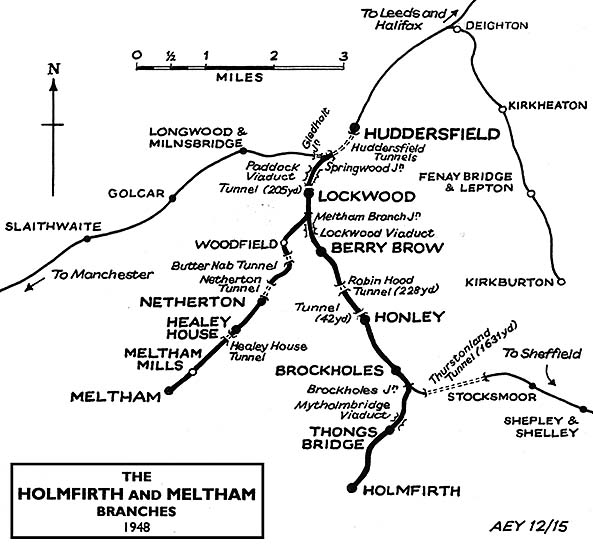
Departures: weekdays
December 1895 |
Destination |
Arrivals: weekdays |
Origin |
5.45am |
Bradford ¶ |
5.33am |
Huddersfield |
6.45am |
Bradford ¶ |
6.27am |
Huddersfield |
7.37am |
Bradford § |
7.30am |
Halifax |
8.33am |
Bradford ¶ |
8.15am |
Bradford ¶ |
9.30am |
Bradford ‡ |
9.20am |
Bradford ¶ |
11.00am |
Halifax |
10.52am |
Bradford ¶ |
12.37pm |
Bradford ¶ |
12.30pm |
Bradford ¶ |
2.00pm |
Bradford ¶ |
1.50pm |
Bradford ¶ |
3.05pm |
Bradford ¶ |
2.50pm |
Bradford ¶ |
4.50pm |
Bradford ¶ |
4.42pm |
Bradford ¶ |
6.03pm |
Bradford ¶ |
5.50pm |
Bradford ‡ |
7.00pm |
Bradford ¶ |
5.37pm |
Bradford ‡ |
7.55pm |
Halifax |
7.32pm |
Bradford |
9.18pm |
Bradford ¶ |
9.10pm |
Huddersfield |
9.35pm (Sat only) |
Huddersfield |
9.25pm (Sat only) |
Huddersfield |
11.00pm |
Bradford ¶ |
10.50pm |
Halifax |
- |
- |
11.20pm (Sat only) |
Bradford ¶ |
Departures: Sunday |
Destination |
Arrivals: Sunday |
Origin |
9.10am |
Bradford ¶ |
9.00am |
Huddersfield |
10.57am |
Bradford ¶ |
10.48am |
Bradford ¶ |
5.05pm |
Bradford ¶ |
3.15pm |
Bradford ¶ |
8.15pm |
Bradford ¶ |
8.00pm |
Huddersfield |
KEY; ¶ via Halifax § via Clifton Road ‡ via Mirfield
 The line was well patronised, its trains regularly formed of three or more carriages; Earnshaw remarks that prior to World War I services were often so crowded that ticket collectors boarded evening trains at Thongs Bridge to relieve congestion at Holmfirth’s ticket barrier. Most passenger trains were hauled by L&Y 0-4-4Ts and 0-6-2Ts until about 1900 when Aspinall 2-4-2Ts were introduced. Early twentieth century goods traffic was generally hauled by LYR A-Class 0-6-0s and 0-8-0s with coal the principal inbound traffic and woollen products being dispatched. The line was well patronised, its trains regularly formed of three or more carriages; Earnshaw remarks that prior to World War I services were often so crowded that ticket collectors boarded evening trains at Thongs Bridge to relieve congestion at Holmfirth’s ticket barrier. Most passenger trains were hauled by L&Y 0-4-4Ts and 0-6-2Ts until about 1900 when Aspinall 2-4-2Ts were introduced. Early twentieth century goods traffic was generally hauled by LYR A-Class 0-6-0s and 0-8-0s with coal the principal inbound traffic and woollen products being dispatched.

The LYR system was absorbed by the London & North Western Railway in January 1922 and in January 1923 the Holmfirth branch became part of the London, Midland & Scottish Railway (LMS). At this time the passenger train frequency had changed little from that in 1895, as seen in the timetable for July 1922.
Departures: weekdays
July 1922 |
Destination |
Arrivals: weekdays |
Origin |
5.35am |
Huddersfield |
6.00am |
Huddersfield |
6.10am |
Brockholes |
6.27am |
Huddersfield |
6.43am |
Huddersfield |
7.06am |
Huddersfield |
7.15am |
Huddersfield |
8.08am |
Huddersfield |
8.25am |
Huddersfield |
9.18am |
Huddersfield |
9.29am |
Huddersfield |
10.35am |
Huddersfield |
10.43am |
Huddersfield |
12.32pm |
Huddersfield |
12.50pm |
Huddersfield |
1.47pm |
Huddersfield |
1.55pm |
Huddersfield |
2.55pm |
Huddersfield |
3.05pm |
Huddersfield |
4.33pm |
Huddersfield |
4.42pm |
Huddersfield |
5.41pm |
Huddersfield |
5.56pm |
Huddersfield |
6.17pm (Sat excepted) |
Huddersfield |
7.00pm |
Huddersfield |
6.50pm (Sat only) |
Huddersfield |
7.57pm |
Huddersfield |
7.48pm |
Huddersfield |
8.50pm |
Huddersfield |
8.36pm |
Huddersfield |
9.20pm (Sat only) |
Huddersfield |
9.11pm (Sat only) |
Huddersfield |
- |
- |
9.46pm |
Huddersfield |
- |
- |
10.58pm |
Huddersfield |
Departures: Sunday |
Destination |
Arrivals: Sunday |
Origin |
9.00am |
Huddersfield |
10.48am |
Huddersfield |
11.10am |
Huddersfield |
7.58pm |
Huddersfield |
8.20pm |
Huddersfield |
10.39pm |
Huddersfield |
However, as elsewhere, buses were to lure passengers away from the railway. Holmfirth’s station was a half-mile uphill walk from the town centre along an increasingly busy road, which deterred would-be passengers when buses could collect or drop them in the centre. The frequent train service was maintained until World War 2. The use of Fowler 2-6-4T locos on the branch damaged the turntable at Holmfirth, and late in 1938 it was dismantled and a run-round loop replaced it; thereafter most trains worked tender-first to Holmfirth and smokebox-first in the opposite direction.
 Whilst in summer 1938 a frequent train service was maintained in the face of bus competition, it was significantly reduced after the outbreak of World War 2 – an economy that affected many British lines. In June 1943 the passenger service had declined to seven departures on Monday-to-Friday, eight on Saturday and no Sunday trains. The first British Railways (BR) London Midland Region timetable of summer 1948 showed a slight reduction to six weekday departures. On 2 April 1950 in a BR regional boundary adjustment the branch was transferred to the North Eastern Region, although the branch was not included in that region’s timetable until winter 1950-51 (commencing 25 September). No Sunday service was provided on the branch. Whilst in summer 1938 a frequent train service was maintained in the face of bus competition, it was significantly reduced after the outbreak of World War 2 – an economy that affected many British lines. In June 1943 the passenger service had declined to seven departures on Monday-to-Friday, eight on Saturday and no Sunday trains. The first British Railways (BR) London Midland Region timetable of summer 1948 showed a slight reduction to six weekday departures. On 2 April 1950 in a BR regional boundary adjustment the branch was transferred to the North Eastern Region, although the branch was not included in that region’s timetable until winter 1950-51 (commencing 25 September). No Sunday service was provided on the branch.
Departures: weekdays
September 1950 |
Destination |
Arrivals: weekdays |
Origin |
6.37am |
Low Moor |
7.03am (Sat excepted) |
Halifax |
7.12am (Sat excepted) |
Halifax |
8.05am |
Huddersfield |
8.27am |
Huddersfield |
1.02pm |
Huddersfield |
10.32pm |
Bradford Exchange |
4.30pm |
Mirfield |
1.33pm |
Huddersfield |
5.42pm |
Bradford Exchange |
4.53pm (Sat only) |
Leeds City |
6.25pm (Sat excepted) |
Huddersfield |
5.00pm (Sat excepted) |
Bradford Exchange |
- |
- |
 In 1955/56 the woollen ‘tranship’ warehouse was demolished. Use of the branch continued to decline during the 1950s, and the train service dwindled to only three departures on weekdays in the summer 1959 timetable: morning trains to Halifax Town and Huddersfield and an early evening train to Bradford Exchange. Three trains arrived, two from Huddersfield and one from Leeds City. The passenger service ended on 2 November 1959, the date when the formal winter timetable began – almost two months later than normal owing to a printing dispute which delayed timetable production. Erroneously the Holmfirth service appeared in the winter 1959-60 timetable book; the closure of the branch coincided with the introduction of diesel multiple units on the Huddersfield-Penistone line, and the three phantom Holmfirth branch trains in each direction were also shown as diesel-operated. So it was that steam haulage was retained until the end on the branch, and Holmfirth station also kept its traditional atmosphere with gas lighting and, it appears, no BR signage, although a coat of BR(NE) oriental blue paint was applied to the woodwork and verandah. In 1955/56 the woollen ‘tranship’ warehouse was demolished. Use of the branch continued to decline during the 1950s, and the train service dwindled to only three departures on weekdays in the summer 1959 timetable: morning trains to Halifax Town and Huddersfield and an early evening train to Bradford Exchange. Three trains arrived, two from Huddersfield and one from Leeds City. The passenger service ended on 2 November 1959, the date when the formal winter timetable began – almost two months later than normal owing to a printing dispute which delayed timetable production. Erroneously the Holmfirth service appeared in the winter 1959-60 timetable book; the closure of the branch coincided with the introduction of diesel multiple units on the Huddersfield-Penistone line, and the three phantom Holmfirth branch trains in each direction were also shown as diesel-operated. So it was that steam haulage was retained until the end on the branch, and Holmfirth station also kept its traditional atmosphere with gas lighting and, it appears, no BR signage, although a coat of BR(NE) oriental blue paint was applied to the woodwork and verandah.
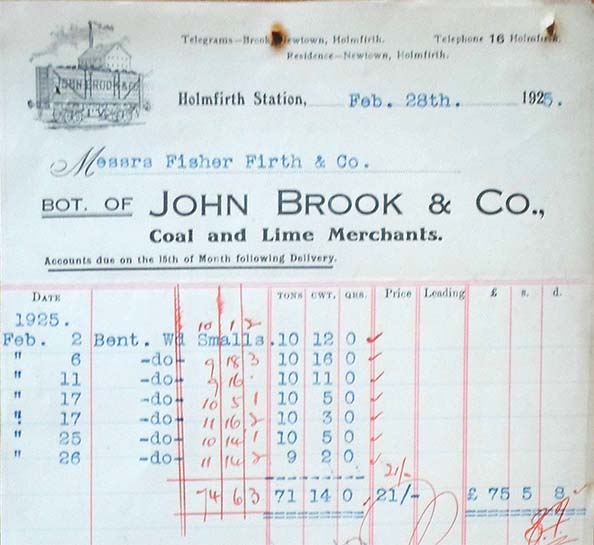
 After closure the branch was singled (1961) and Holmfirth signal box was decommissioned. At least three DMU excursions visited the branch, including an RCTS special in September 1964 and a school special to Wakefield in March 1965. On 3 May 1965 the branch was finally closed; Earnshaw notes that towards the end of April Type 4 diesel No. D259 ran trials along the branch and 8F No. 48305 had the sad task of hauling away the last few remaining empty wagons. The rails were removed during 1966 and Holmfirth station stood derelict for many years. The office and waiting room range, together with the verandah, was demolished in the mid 1980s and a place of worship was built on the northern end of the station site in 1985. The station building was restored for residential use, its elegant platform elevation marred by a two-storey flat-roofed extension, later remodelled with a tasteful gable more in keeping with the Grade II listed structure to which it is attached. In February 2016 the station building was empty but, advertised as ‘station master’s house’, it had been sold. The former trackbed was also available to buy for residential use, so it will presumably soon be built upon. After closure the branch was singled (1961) and Holmfirth signal box was decommissioned. At least three DMU excursions visited the branch, including an RCTS special in September 1964 and a school special to Wakefield in March 1965. On 3 May 1965 the branch was finally closed; Earnshaw notes that towards the end of April Type 4 diesel No. D259 ran trials along the branch and 8F No. 48305 had the sad task of hauling away the last few remaining empty wagons. The rails were removed during 1966 and Holmfirth station stood derelict for many years. The office and waiting room range, together with the verandah, was demolished in the mid 1980s and a place of worship was built on the northern end of the station site in 1985. The station building was restored for residential use, its elegant platform elevation marred by a two-storey flat-roofed extension, later remodelled with a tasteful gable more in keeping with the Grade II listed structure to which it is attached. In February 2016 the station building was empty but, advertised as ‘station master’s house’, it had been sold. The former trackbed was also available to buy for residential use, so it will presumably soon be built upon.
Sadly, the tourists seeking a quaint ‘Summer Wine’ experience in Holmfirth, including horse-drawn tours of the town and afternoon tea in ‘Sid’s Café’, are denied the pleasure of arriving by train. How delightful a steam-hauled shuttle service from Brockholes would be!
Route map drawn by Alan Young. Tickets from Michael Stewart. Bradshaw from Alan Young,
Click here for a brief history of the Holmfirth branch.
To see other stations on the Holmfirth branch
click on the station name:
Thongs Bridge & Brockholes |



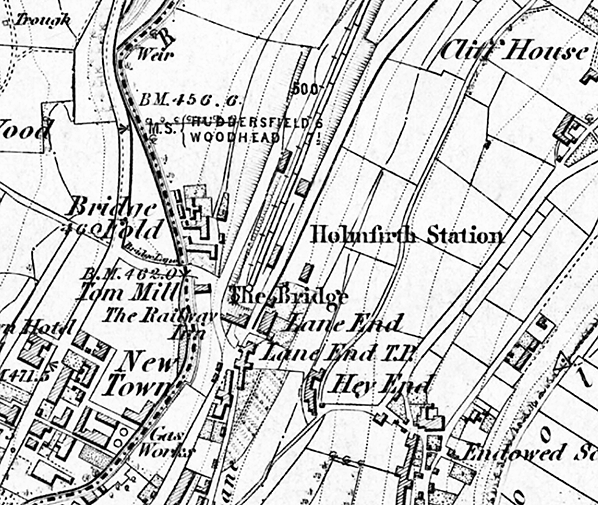

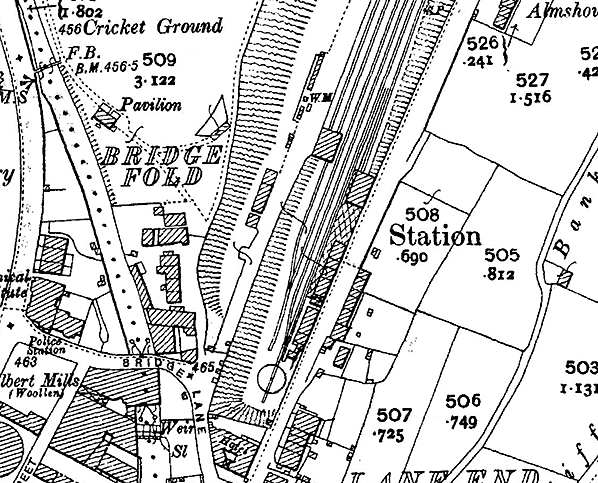


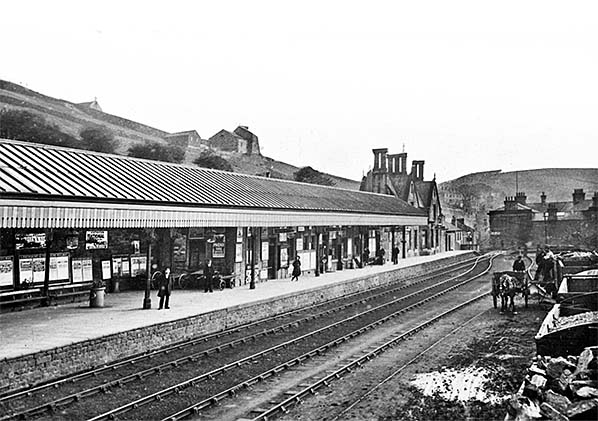
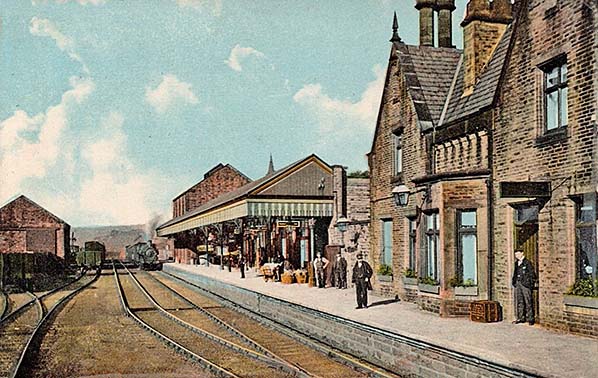

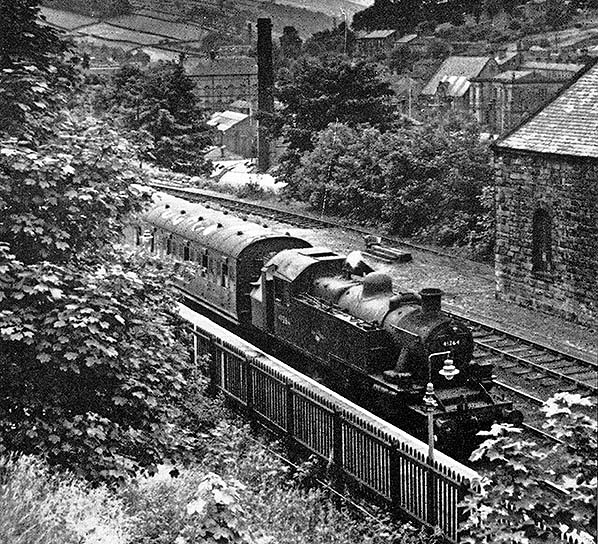
 Notes: The AA Illustrated road book of England & Wales (1961) dismissed Holmfirth with not so much as a description, merely noting its population of 18,790, early closing day on Tuesday and market day on Thursday, then referring to Saddleworth Moor and Holme Moss BBC television transmitter. Thanks to the BBC the town is now a tourist destination as the setting for the much-loved comedy Last of the Summer Wine; earlier generations chuckled (or winced!) at the saucy seaside postcards produced by Bamforth’s of Holmfirth. The town owes its growth to the woollen industry, originally found in cottages on the surrounding hills where spinning and weaving was carried out and fine worsteds were manufactured. In the late eighteenth and nineteenth centuries production migrated downhill to water mills within Holmfirth’s steep valley, powered by swift streams and, later, reservoirs. Terraces and cottages of sandstone clamber up the steep valley sides of this quaint Pennine town, which was reached in 1850 by a branch railway. The economy of the town was boosted by its new railway and by the use of steam power in the mills which used coal brought in by rail.
Notes: The AA Illustrated road book of England & Wales (1961) dismissed Holmfirth with not so much as a description, merely noting its population of 18,790, early closing day on Tuesday and market day on Thursday, then referring to Saddleworth Moor and Holme Moss BBC television transmitter. Thanks to the BBC the town is now a tourist destination as the setting for the much-loved comedy Last of the Summer Wine; earlier generations chuckled (or winced!) at the saucy seaside postcards produced by Bamforth’s of Holmfirth. The town owes its growth to the woollen industry, originally found in cottages on the surrounding hills where spinning and weaving was carried out and fine worsteds were manufactured. In the late eighteenth and nineteenth centuries production migrated downhill to water mills within Holmfirth’s steep valley, powered by swift streams and, later, reservoirs. Terraces and cottages of sandstone clamber up the steep valley sides of this quaint Pennine town, which was reached in 1850 by a branch railway. The economy of the town was boosted by its new railway and by the use of steam power in the mills which used coal brought in by rail. Goods facilities were west of the passenger station, including a single-road stone-built shed and a 10-ton crane. Textiles and metal castings were the principal traffic handled. North-east of the station building stood a woollen transhipment shed, behind the platform, and a siding passed through it. After the remodelling of the station, the rails were cut back to end at the northern wall of the shed. A Gloucester Wagon Company signal box stood north of the passenger station and east of the tracks; it was replaced in 1899 with a standard L&Y box after the original one was damaged by fire.
Goods facilities were west of the passenger station, including a single-road stone-built shed and a 10-ton crane. Textiles and metal castings were the principal traffic handled. North-east of the station building stood a woollen transhipment shed, behind the platform, and a siding passed through it. After the remodelling of the station, the rails were cut back to end at the northern wall of the shed. A Gloucester Wagon Company signal box stood north of the passenger station and east of the tracks; it was replaced in 1899 with a standard L&Y box after the original one was damaged by fire.
 The line was well patronised, its trains regularly formed of three or more carriages; Earnshaw remarks that prior to World War I services were often so crowded that ticket collectors boarded evening trains at Thongs Bridge to relieve congestion at Holmfirth’s ticket barrier. Most passenger trains were hauled by L&Y 0-4-4Ts and 0-6-2Ts until about 1900 when Aspinall 2-4-2Ts were introduced. Early twentieth century goods traffic was generally hauled by LYR A-Class 0-6-0s and 0-8-0s with coal the principal inbound traffic and woollen products being dispatched.
The line was well patronised, its trains regularly formed of three or more carriages; Earnshaw remarks that prior to World War I services were often so crowded that ticket collectors boarded evening trains at Thongs Bridge to relieve congestion at Holmfirth’s ticket barrier. Most passenger trains were hauled by L&Y 0-4-4Ts and 0-6-2Ts until about 1900 when Aspinall 2-4-2Ts were introduced. Early twentieth century goods traffic was generally hauled by LYR A-Class 0-6-0s and 0-8-0s with coal the principal inbound traffic and woollen products being dispatched. 
 Whilst in summer 1938 a frequent train service was maintained in the face of bus competition, it was significantly reduced after the outbreak of World War 2 – an economy that affected many British lines. In June 1943 the passenger service had declined to seven departures on Monday-to-Friday, eight on Saturday and no Sunday trains. The first British Railways (BR) London Midland Region timetable of summer 1948 showed a slight reduction to six weekday departures. On 2 April 1950 in a BR regional boundary adjustment the branch was transferred to the North Eastern Region, although the branch was not included in that region’s timetable until winter 1950-51 (commencing 25 September). No Sunday service was provided on the branch.
Whilst in summer 1938 a frequent train service was maintained in the face of bus competition, it was significantly reduced after the outbreak of World War 2 – an economy that affected many British lines. In June 1943 the passenger service had declined to seven departures on Monday-to-Friday, eight on Saturday and no Sunday trains. The first British Railways (BR) London Midland Region timetable of summer 1948 showed a slight reduction to six weekday departures. On 2 April 1950 in a BR regional boundary adjustment the branch was transferred to the North Eastern Region, although the branch was not included in that region’s timetable until winter 1950-51 (commencing 25 September). No Sunday service was provided on the branch. In 1955/56 the woollen ‘tranship’ warehouse was demolished. Use of the branch continued to decline during the 1950s, and the train service dwindled to only three departures on weekdays in the summer 1959 timetable: morning trains to Halifax Town and Huddersfield and an early evening train to Bradford Exchange. Three trains arrived, two from Huddersfield and one from Leeds City. The passenger service ended on 2 November 1959, the date when the formal winter timetable began – almost two months later than normal owing to a printing dispute which delayed timetable production. Erroneously the Holmfirth service appeared in the winter 1959-60 timetable book; the closure of the branch coincided with the introduction of diesel multiple units on the Huddersfield-Penistone line, and the three phantom Holmfirth branch trains in each direction were also shown as diesel-operated. So it was that steam haulage was retained until the end on the branch, and Holmfirth station also kept its traditional atmosphere with gas lighting and, it appears, no BR signage, although a coat of BR(NE) oriental blue paint was applied to the woodwork and verandah.
In 1955/56 the woollen ‘tranship’ warehouse was demolished. Use of the branch continued to decline during the 1950s, and the train service dwindled to only three departures on weekdays in the summer 1959 timetable: morning trains to Halifax Town and Huddersfield and an early evening train to Bradford Exchange. Three trains arrived, two from Huddersfield and one from Leeds City. The passenger service ended on 2 November 1959, the date when the formal winter timetable began – almost two months later than normal owing to a printing dispute which delayed timetable production. Erroneously the Holmfirth service appeared in the winter 1959-60 timetable book; the closure of the branch coincided with the introduction of diesel multiple units on the Huddersfield-Penistone line, and the three phantom Holmfirth branch trains in each direction were also shown as diesel-operated. So it was that steam haulage was retained until the end on the branch, and Holmfirth station also kept its traditional atmosphere with gas lighting and, it appears, no BR signage, although a coat of BR(NE) oriental blue paint was applied to the woodwork and verandah. 
 After closure the branch was singled (1961) and Holmfirth signal box was decommissioned. At least three DMU excursions visited the branch, including an RCTS special in September 1964 and a school special to Wakefield in March 1965. On 3 May 1965 the branch was finally closed; Earnshaw notes that towards the end of April Type 4 diesel No. D259 ran trials along the branch and 8F No. 48305 had the sad task of hauling away the last few remaining empty wagons. The rails were removed during 1966 and Holmfirth station stood derelict for many years. The office and waiting room range, together with the verandah, was demolished in the mid 1980s and a place of worship was built on the northern end of the station site in 1985. The station building was restored for residential use, its elegant platform elevation marred by a two-storey flat-roofed extension, later remodelled with a tasteful gable more in keeping with the Grade II listed structure to which it is attached. In February 2016 the station building was empty but, advertised as ‘station master’s house’, it had been sold. The former trackbed was also available to buy for residential use, so it will presumably soon be built upon.
After closure the branch was singled (1961) and Holmfirth signal box was decommissioned. At least three DMU excursions visited the branch, including an RCTS special in September 1964 and a school special to Wakefield in March 1965. On 3 May 1965 the branch was finally closed; Earnshaw notes that towards the end of April Type 4 diesel No. D259 ran trials along the branch and 8F No. 48305 had the sad task of hauling away the last few remaining empty wagons. The rails were removed during 1966 and Holmfirth station stood derelict for many years. The office and waiting room range, together with the verandah, was demolished in the mid 1980s and a place of worship was built on the northern end of the station site in 1985. The station building was restored for residential use, its elegant platform elevation marred by a two-storey flat-roofed extension, later remodelled with a tasteful gable more in keeping with the Grade II listed structure to which it is attached. In February 2016 the station building was empty but, advertised as ‘station master’s house’, it had been sold. The former trackbed was also available to buy for residential use, so it will presumably soon be built upon.
 Home Page
Home Page